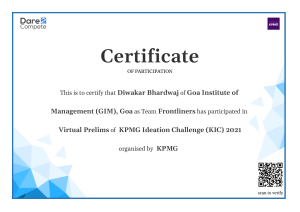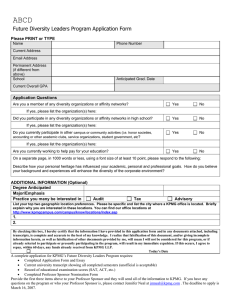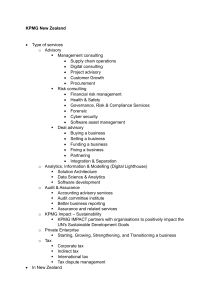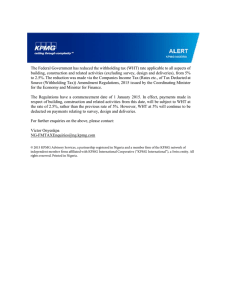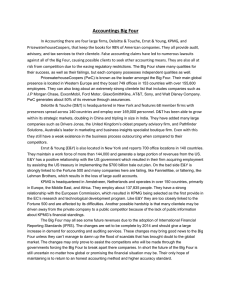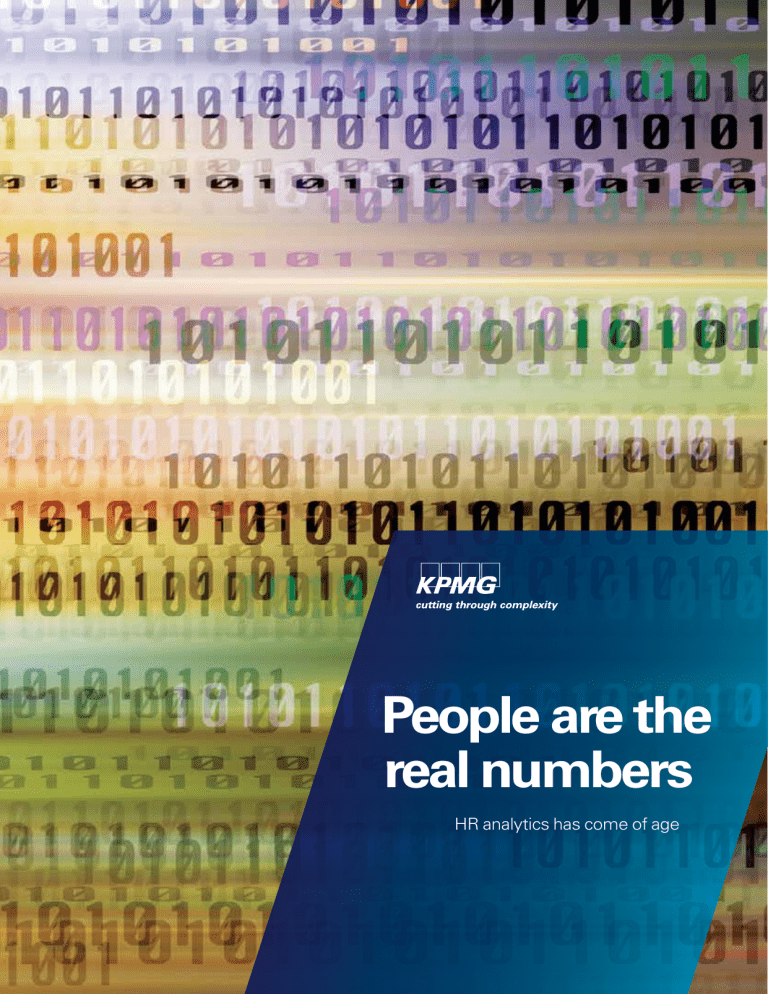
People are the real numbers HR analytics has come of age Contents Long on info, short on insight 2 The status quo is the problem 4 Where we want to get to Case study: Measuring what matters 9 16 HR analytics has come of age KPMG HR Transformation | 1 © 2013 KPMG International Cooperative (“KPMG International”), a Swiss entity. Member firms of the KPMG network of independent firms are affiliated with KPMG International. KPMG International provides no client services. All rights reserved. Long on info, short on insight Most HR teams understand the potential value of HR analytics yet they continue to offer only generic and basic operational and transactional measurements – metrics that provide little in the way of predictive data or actual insights that could have a positive impact on the success of the organization. This was confirmed in an Economist Intelligence Unit survey of 418 global executives commissioned by KPMG International in which 85 percent of respondents said their HR team doesn’t excel at providing insightful and predictive analytics. Rear view mirror Essentially, HR’s current approach to analytics remains anchored in the present and in the past: staff turnover, employee engagement, diversity statistics and promotion rates. It’s concerned with what’s gone before, with the existing workforce and with its organization’s immediate priorities, rather than providing executivelevel leadership with tangible intelligence about what’s going to happen tomorrow, next year or next decade – and why that will be important to the business. Yet if HR is to harbor any hope of proving its business value to the organization, let alone taking up residence among the leadership team, senior HR managers need to approach analytics in a much more strategic way. Applied properly, HR analytics can show connections, correlations and even causality between HR metrics and other business measures – all of which can be used to inform HR strategy and actions. In other words, by creating a clear ‘line of sight’ between HR activity and your organization’s bottom-line profitability, HR analytics can provide a tangible link between your people strategy and your organization’s performance. “I believe that well thoughtout predictive HR analytics could become as important to the CEO as the balance sheet and P&L statement,” says Robert Bolton, a KPMG Advisory partner and HR Transformation expert in the UK. “HR analytics are actually HR’s best-kept secret,” says Robert. “After all, if CEOs were aware of what this data can show them – if they could cut through its complexity to access and exploit it in the way they want to – they would be extremely interested in HR analytics as a whole.” Source – Economist Intelligence Unit Study, commissioned by KPMG International: Rethinking Human Resources in a Changing World, 2012. 2 | KPMG HR Transformation People are the real numbers © 2013 KPMG International Cooperative (“KPMG International”), a Swiss entity. Member firms of the KPMG network of independent firms are affiliated with KPMG International. KPMG International provides no client services. All rights reserved. And now is the perfect time for HR to up its analytics game. The widespread adoption of HR management systems and the advent of cloud storage are making it easy for organizations to maintain all of their HR data in one place and to share and integrate it with other critical management information. Likewise, the software needed to carry out complex statistical analysis is now more affordable and readily available. Employers seem ready to take advantage of these developments – the aforementioned Economist Intelligence Unit research found that 31 percent of organizations plan to invest in data analytics during the next three years. Why the current focus on analytics? According to Tim Payne, a KPMG talent management leader in the UK, “We believe three trends are creating this momentum. The first is that HR systems are increasingly integrated and allow easier access to both sides of the regression equation -- input measures on people’s characteristics and output measures such as sales data. The second is the general buzz around big data and data analytics across the business world. Thirdly, and potentially most interesting, is the availability of social data.” The new breed of social HR systems is introducing social connections not only to recruitment and learning and development, but also to performance management and reward and recognition. This blurring of the lines between HR and knowledge management offers exciting analytic possibilities that are genuinely new and ground breaking. HR can seize on this opportunity to move its measurement up a level and transform itself from a fundamentally administrative and back office function into a strategic partner capable of showing company leadership how well the organization’s people programs are aligned with the business strategy and how much value they’re adding to the company’s results. This report offers a road map for turning this aspiration into reality. HR analytics has come of age KPMG HR Transformation | 3 © 2013 KPMG International Cooperative (“KPMG International”), a Swiss entity. Member firms of the KPMG network of independent firms are affiliated with KPMG International. KPMG International provides no client services. All rights reserved. The status quo is the problem Defining HR analytics Human capital measurement. Big data. Talent analytics. Strategic workforce analytics. HR analytics. These terms all refer to the synthesis of qualitative and quantitative data and information to bring predictive insight and decision making support to the management of people in organizations. To put it another way, HR analytics can be seen as the application of statistical techniques (for example, factor analysis, regression and correlation) and the synthesis of multiple sources to create meaningful insights – for example, employee retention in office X is driven by factors Y and Z. 4 | KPMG HR Transformation People Peopleare arethe thereal realnumbers numbers © 2013 KPMG International Cooperative (“KPMG International”), a Swiss entity. Member firms of the KPMG network of independent firms are affiliated with KPMG International. KPMG International provides no client services. All rights reserved. HR analytics: the current issues For at least the past two decades, HR professionals have been working hard to earn a place at the leadership table by helping to transform the organization’s people into strategic players who consistently deliver and prove their value to the business. For the most part though, they have been unsuccessful. This is largely because HR has been attempting to apply generic best practice models to businesses that really require tailored approaches that are relevant to their business strategies, priorities and operating models. For example, an organization that has adopted the Value Disciplines Model developed by Michael Treacy and Fred Wiersema, will have chosen to excel in ‘operational excellence’, ‘product leadership’ or ‘customer intimacy’ – or a unique configuration of the three. Explains Robert: “When it comes to the Value Disciplines Model, very few businesses will have prioritized the same values to the same degree.” “And yet in spite of this, if you look at a random selection of HR teams right now, you’ll see more similarities than differences. In short, HR is far too generic and undifferentiated in pursuit of competitive advantage. It needs to ‘place its bets’ more. I simply don’t see how that can be right.” Source: The Discipline of Market Leaders, Treacy & Wiersema, Basic Books 1997. “How can an HR team that supports a business whose unique selling proposition is based around innovation to drive ‘product leadership’ be so similar to a team supporting a business based around ‘operational excellence’?” asks Robert. “An HR function in a marketleading global technology company must find a very different role in relation to the value chain than its equivalent, a global hotel chain, for example. Both functions should be uniquely configured in order to drive value based on what’s most important to their business.” This flawed use of generic HR models is never truer than when it comes to how HR uses data – a practice known as human capital measurement or, more commonly nowadays, HR analytics (as defined on the opposite page). HR analytics has come of age KPMG HR Transformation | 5 © 2013 KPMG International Cooperative (“KPMG International”), a Swiss entity. Member firms of the KPMG network of independent firms are affiliated with KPMG International. KPMG International provides no client services. All rights reserved. The current state of HR analytics Fuelled by the relentless flow of numbers that emerges from any typical enterprise resource planning (ERP) program, most employers maintain at least some basic HR metrics – whether it’s workforce demographics, staff turnover rates, absence levels, training spend or cost-per-hire. While these operational and transactional measures may be useful, they do little more than provide a ‘rear view mirror’ or historical perspective of HR’s activities. Other organizations do take things one step further – carrying out a basic analysis of these figures. They may compare figures from previous years to assess progress or decline, for example – or use data to benchmark their business’ performance against that of other organizations in the same industry or region. But HR analytics can, should – and must – go far beyond even this second level. “Applied properly, HR analytics can show connections, correlations and even causality between HR metrics and other business measures – all of which can be used to drive HR strategy and actions,” says Robert. bottom-line profitability, HR analytics can provide that link between people management and business results. So what, specifically, is stopping HR from unlocking the full potential of analytics? The data is too fragmented or dispersed For many organizations, the fundamental problems are those of data quality and access. Says Robert: “There is a tremendous amount of employee-related data available. But it’s not always consistent. And it may be in several different places – making it very hard to get at or to use in any meaningful way. “For example, a lot of organizations keep individual training records in one learning management system, recruiting data in applicant tracking systems, absence data in a labor system and performance management information in manager’s desk files,” he says. Other data-related problems are caused by: “For example, while it’s helpful to track absences by location or versus prior years, if HR could also show that improvements in absenteeism positively correlated with manufacturing cost efficiency, line leaders would be more likely to see the value of HR,” he says. • Complex data architecture models – a legacy of multiple reorganizations, mergers and acquisitions “And if HR was able to show that focusing on attendance and wellness programs caused a positive business impact, HR may well find itself helping to shape its organization’s strategy,” adds Tim. • Pulling data from separate systems with inconsistent definitions (such as HR, payroll, training and talent systems) In other words, by creating a clear ‘line of sight’ between HR interventions and 6 | KPMG HR Transformation • Overly complex entry codes for different HR actions – such as numerous termination or hiring reasons • A lack of rigor, promptness or controls for completeness • Inconsistencies from employee selfservice (or lack of self-service). HR is asking the wrong questions Even among organizations that store all of their HR data in an accurate and consistent format on a single system, few tend to carry out more than routine analyses of their information. “This is because on its own, the data that most organizations collect holds little value,” explains Robert. “Measures of absenteeism and staff turnover don’t tell you very much,’ he says. “For example, absenteeism doesn’t tell you whether business performance has declined, or whether it’s good or poor performers who are absent.” People are the real numbers © 2013 KPMG International Cooperative (“KPMG International”), a Swiss entity. Member firms of the KPMG network of independent firms are affiliated with KPMG International. KPMG International provides no client services. All rights reserved. Adds Robert: “Many organizations now possess a wide range of relevant quantitative and qualitative information within and beyond the HR arena. But this isn’t being connected or effectively mined or analyzed to create deeper business insight. Essentially, analysts in HR are bogged down with basic workforce metrics – and not enough focus on understanding the link to business outcomes. To be effective in analytics, HR professionals must first form some hypotheses that are worth exploring. Without a hypothesis, all you have is data and not the predictive insights that help you shape strategy.” HR HRanalytics analyticshas hascome comeofofage age KPMG HR Transformation | 7 © 2013 KPMG International Cooperative (“KPMG International”), a Swiss entity. Member firms of the KPMG network of independent firms are affiliated with KPMG International. KPMG International provides no client services. All rights reserved. HR lacks the right skills According to the EIU study: In many cases, HR lacks the skills required to carry out the sort of complex statistical analysis required to properly unlock the power of HR analytics. In addition, organizations need to provide the resources, time and training to create this new breed of HR analytics specialists. 56 % HR functions report an increase in using data analytics compared to three years ago “Historically, statistics has not been a requirement of most HR roles,” says Tim. Time for change? plan to implement new technology to support this With all this in mind, it is arguably little wonder that HR’s approach to designing, developing, implementing and sustaining people strategies remains anchored in the present, concerned with the existing workforce and the immediate business priorities – rather than able to provide senior leadership with insight into what’s going to happen tomorrow and next year. And it’s perhaps also unsurprising that, according to KPMG Internationalcommissioned Economist Intelligence Unit (EIU) research, 85 percent of respondents said their HR team doesn’t excel at providing insightful and predictive analytics. This is a true call to action – given that HR analytics appear to be attracting an increasing amount of attention. There’s never been a better time to plan and implement a more advanced yet practical approach to collecting, analyzing and communicating the business insights that can be gleaned from the right HR data. 31% 23 % reported that adopting new technologies, such as data analytics, would be their main focus in the next three years What’s the best way forward? Source: Economist Intelligence Unit Study, commissioned by KPMG International: Rethinking Human Resources in a Changing World, 2012. 8 | KPMG HR Transformation People are the real numbers © 2013 KPMG International Cooperative (“KPMG International”), a Swiss entity. Member firms of the KPMG network of independent firms are affiliated with KPMG International. KPMG International provides no client services. All rights reserved. Where we want to get to HR analytics has come of age KPMG HR Transformation | 9 © 2013 KPMG International Cooperative (“KPMG International”), a Swiss entity. Member firms of the KPMG network of independent firms are affiliated with KPMG International. KPMG International provides no client services. All rights reserved. Getting it right Broadening out your information gathering There are no quick fixes for these issues but taking a broader approach to gathering HR information is the best place to start. HR needs to move beyond the present and the purely informational into the predictive and insightful. This is the essence of a genuine paradigm shift in the way HR functions create value and how they are beginning to view their role in collecting, connecting and sharing data that will influence decisions about the future direction of the business. Says Robert: “This means gathering data from a much broader range of sources. Only then will HR have the 360 degree view it needs to shape the right people agenda and measure progress against it.” The basic foundation of any HR database, internal colleague data such as master data, talent, performance and succession depth – combined with exit interviews, offer rejection reasons, employee engagement results, employee surveys and expatriate success – provides a good starting point. 10 | KPMG HR Transformation Next come internal data showing the connection with HR activity and business priorities – so, business performance by geography, market and sector; actual and planned growth and a 360-degree view of colleagues and HR. Finally, external data provides context and opportunity. This data could include: • Economic indicators, employment availability • Competitors’ performance • Key industry measures of business and HR • Social media listening about a company and its competitors. “So, for example,” explains Robert, “your organization’s HR team may need to move beyond paying attention to only the number of hires this year compared with last year and the data from the annual staff engagement survey – and add to this the data from continuous performance reviews or from what employees past, present and future are saying about their organization on social media platforms.” Integrating your data Solving the problem of fragmented and dispersed data, meanwhile, calls for a potentially expensive and time-consuming process. It could take months to clean up the HR data held by a large, multinational organization – so senior managers would need to be convinced of the value of the exercise before giving the go ahead to proceed. People are the real numbers © 2013 KPMG International Cooperative (“KPMG International”), a Swiss entity. Member firms of the KPMG network of independent firms are affiliated with KPMG International. KPMG International provides no client services. All rights reserved. “Fortunately,” says Robert, “new technology – particularly the introduction of cloud-based HR management systems such as Workday, in addition to established ERP solutions like SAP and Oracle – is making it easier for organizations to maintain all of their HR data in a single, standard format. For many employers, this will mean an end to the problem of inconsistent, dispersed data.” Build a statistical skill set in HR Once they’ve broadened out their data sources and integrated them into one system, HR leaders will need to hire a new kind of HR specialist to make the most of it. Says Robert: “Historically, statistics and data analysis hasn’t been a requirement of most HR roles. However, if HR is going to get this right, it will need to begin hiring people and building teams with quantitative analysis skills.” Right questions, right insights With the right information, the right system and the right people in place, HR then needs to start asking the right questions. Explains Tim: “HR professionals shouldn’t just start with charting a lot of data and hoping it will give them some answers. They should instead be starting with a question: What is it that we want to know? “In other words, analytics should be less about raw data and more about what insights occur when you combine a range of measurements and use analysis to test questions or hypotheses that are relevant to your business.” For example: • Where does increased diversity and inclusion deliver better business results? • Which employee compensation and benefits programs drive higher retention rates? • At what levels do internal mobility-driven career opportunities lead to higher engagement levels? • Which employees have the highest contribution to your organization’s profitability? • Which roles are the most critical to the company’s success – and are you sure you have the best people in these roles? Are you providing them with the right rewards and development? • How does HR contribute to the overall success of your organization? • Are your people fully engaged? Does engagement actually deliver higher profits? HR analytics has come of age KPMG HR Transformation | 11 © 2013 KPMG International Cooperative (“KPMG International”), a Swiss entity. Member firms of the KPMG network of independent firms are affiliated with KPMG International. KPMG International provides no client services. All rights reserved. Different organization, different questions • build a people program that’s fully integrated with the strategy and that’s capable of fully supporting it. Yet the questions that are right for your organization may be irrelevant for another. But most importantly, in relation to HR analytics, the framework also helps practitioners decide what they need to know in order to track the progress of their people programs. As suggested earlier in this report, the shape of your HR team, your people program – and the analytics that underpin it – must all be driven by your unique competitive landscape, customers and products. No two suites of HR analytics questions should be alike. Taking a generic and best practice approach simply limits your ability to help your organization generate competitive advantage. So how can you be sure you’re asking the right questions and collecting the right kind of workforce data for your organization? KPMG’s Strategic Workforce Framework The KPMG Strategic Workforce Framework provides a platform on which key people issues can be identified and the overall people agenda can be developed. It helps HR practitioners: Explains Robert: “The framework helps managers create a relatively simple HR analytics dashboard that uses fewer but much more relevant metrics presented in a more meaningful manner.” Using the framework to devise the right dashboard for you The framework comprises five main categories for review and consideration: • Cost • Capacity • Capability • Compliance • Connections. • step back take a look at what’s important to their organization • better understand their organization’s strategy and the ways in which people help to create value 12 | KPMG HR Transformation People are the real numbers © 2013 KPMG International Cooperative (“KPMG International”), a Swiss entity. Member firms of the KPMG network of independent firms are affiliated with KPMG International. KPMG International provides no client services. All rights reserved. KPMG’s Strategic Workforce Framework Connections Capability KPMG’s Strategic Workforce Framework Capacity Compliance Cost HR analytics has come of age KPMG HR Transformation | 13 © 2013 KPMG International Cooperative (“KPMG International”), a Swiss entity. Member firms of the KPMG network of independent firms are affiliated with KPMG International. KPMG International provides no client services. All rights reserved. Coming back to Treacy and Wiersema’s classic three Value Disciplines Model of operational excellence, product leadership or customer intimacy (see page 5), the framework generates a series of hypotheses that will highlight what HR data is needed and what kind of statistical analysis should be applied – depending on which of Treacy and Wiersema’s disciplines is the primary competitive focus for your business. “Coming to the discipline of customer intimacy, using the framework’s ‘capability’ heading would lead you to test whether or not your employees have the knowledge, skills and behavior they need to solve customers’ problems. So, the questions here might look at whether or not your employees are bothering to understand your customer needs or perhaps whether or not they’re upselling as much as possible.” Explains Robert: “If, for example, operational excellence is your primary focus, the framework’s ‘cost’ category will point you toward questions – or lead you to test a hypothesis – about how much of your compensation budget goes to people who directly serve the customer or who are in front line operations, as opposed to middle and back office.” “And looking at ‘connections’ in the context of customer intimacy discipline might lead you to include within your HR data and any subsequent dashboard, a social media analysis of customer feedback, for example.” “Still with the discipline of operational excellence, the framework’s ‘capability’ aspect might lead you to collect and analyze data that helps determine whether or not you have enough people skilled in lean process review,” he says. “The examples are almost infinite,” says Robert. “What questions or hypotheses matter most to you simply comes back to the unique nature and characteristics of your organization.” Workforce analytics -- old wine in new bottles? Tim concludes, “We believe it is imperative for HR functions to embrace the power of workforce analytics and recognize that taking full advantage of these tools will require both a change in mind-set as well as skills. They may not be new, but the opportunity to decant some of this old wine into new bottles and let it breathe could be a heady prospect.” 14 | KPMG HR Transformation People are the real numbers © 2013 KPMG International Cooperative (“KPMG International”), a Swiss entity. Member firms of the KPMG network of independent firms are affiliated with KPMG International. KPMG International provides no client services. All rights reserved. HR data and value creation: a great pairing The essence of analytics is about predicting behavior, and here are three examples of how workforce analytics can reflect a genuine paradigm shift in the way HR creates value and how its role is viewed: 1 Comparing the personality traits or ratings against behavioral competencies of sales people with their actual sales achievements (and identifying those most likely to sell the most) can provide critical information to a business – both in terms of hiring decisions and as a route towards understanding skill development needs within the sales team. Comparing sales people’s characteristics with their sales performance is not new. It’s the very definition of a predictive validity study – something industrial psychologists have been carrying out for years. 2 Modelling the relationship between staff engagement (or components of it) to business outcomes, ranging from staff turnover, absenteeism or productivity, through to financial performance or customer satisfaction (most often in the context of retail outlets) enables a business to target HR interventions that are likely to provide improvements that flow through directly to the customer. There are many examples of research studies that show a direct relationship between increases in employee satisfaction, customer satisfaction and profitability. It’s sometimes referred to as evidence-based HR, and this idea also is not new. 3 It has been more than a decade since studies were first undertaken to understand what employees value and how that affects staff turnover. Identifying clusters or ‘types’ of employees who may share similar career motivations and life circumstances can help an organization offer a range of tailored contract terms and benefits that these employee clusters will find attractive will help to retain and attract top talent. Old wine… in new bottles. The essential ideas may not be new to HR but the rapid acceleration in our ability to collect, integrate and interpret large amounts of data and predict its business impact are important new developments. HR analytics has come of age KPMG HR Transformation | 15 © 2013 KPMG International Cooperative (“KPMG International”), a Swiss entity. Member firms of the KPMG network of independent firms are affiliated with KPMG International. KPMG International provides no client services. All rights reserved. Case study 16 | KPMG 16 | KPMG HR Transformation HR Transformation People People are the arereal thenumbers real numbers © 2013 KPMG International Cooperative (“KPMG International”), a Swiss entity. Member firms of the KPMG network of independent firms are affiliated with KPMG International. KPMG International provides no client services. All rights reserved. Measuring what matters When a major multinational energy company set its sights on developing a powerful analytical framework to help it make the right HR-related decisions on a sustainable basis, it called in a team of KPMG People and Change consultants to help it understand what data it ought to collect – along with the best way to track, analyze and present it to the company’s senior decision makers. The result? A strategic people measurement system directly aligned to the company’s business strategy. Using KPMG’s Strategic Workforce Framework (see page 13), a team of KPMG People and Change consultants began by interviewing managers across the company’s business units. The goal was to define the kind of decisions they needed to make immediately and over the next five years to manage the company’s existing and potential supply of talent – and to clearly identify the kind of HR information they’d need to support these decisions. For example, an executive in charge of a regional extraction operation in the Americas needed to know – on an ongoing basis – how well that business unit’s employee-related costs compared with other business units across the group. The team worked with the executive, using the KPMG Strategic Workforce Framework to help him ask the right questions. This allowed him to access the right HR data in the right way – and, in turn, enabled HR to help him spot trends and relationships within the data. From here, the manager and HR were able to regularly work together to identify potential issues concerning the supply of capable people; how profit-peremployee compared with similar assets around the globe – and whether they were achieving the skills and diversity profile of key energy assets relative to the age of the operation (growth, maturity and run-down). Explains Robert: “Essentially, we turned the client’s approach to HR analytics around by putting users and decision makers such as the business unit executive at the start rather than the end of the company’s data gathering processes. We did this by finding out from them what the client’s people program needed to look like to bring his part of the company’s strategy to life – and also what information he’d need to look at in order to know whether or not the program was working.” “At a broader level, we helped the company find ways to present their HR data more simply and clearly and in a way that linked it to their business issues and what they were trying to do at a group-wide level.” “This gave decision makers insight rather than simply information, thereby providing them with the perspective they needed to better and more easily appreciate the choices before them.” HR analytics has come of age KPMG HR Transformation | 17 © 2013 KPMG International Cooperative (“KPMG International”), a Swiss entity. Member firms of the KPMG network of independent firms are affiliated with KPMG International. KPMG International provides no client services. All rights reserved. Contact us Robert Bolton, KPMG in the UK T: +44 20 73118347 E: robert.bolton@kpmg.co.uk Tim Payne, KPMG in the UK T: +44 20 73118002 E: tim.j.payne@kpmg.co.uk kpmg.com These articles represent the views of the authors only, and does not necessarily represent the views or professional advice of KPMG member firms. The information contained herein is of a general nature and is not intended to address the circumstances of any particular individual or entity. Although we endeavor to provide accurate and timely information, there can be no guarantee that such information is accurate as of the date it is received or that it will continue to be accurate in the future. No one should act on such information without appropriate professional advice after a thorough examination of the particular situation. © 2013 KPMG International Cooperative (“KPMG International”), a Swiss entity. Member firms of the KPMG network of independent firms are affiliated with KPMG International. KPMG International provides no client services. No member firm has any authority to obligate or bind KPMG International or any other member firm vis-à-vis third parties, nor does KPMG International have any such authority to obligate or bind any member firm. All rights reserved. The KPMG name, logo and “cutting through complexity” are registered trademarks or trademarks of KPMG International. Designed by THOUGHT by design Publication name: People are the real numbers Publication number: 121406 Publication date: February 2013
